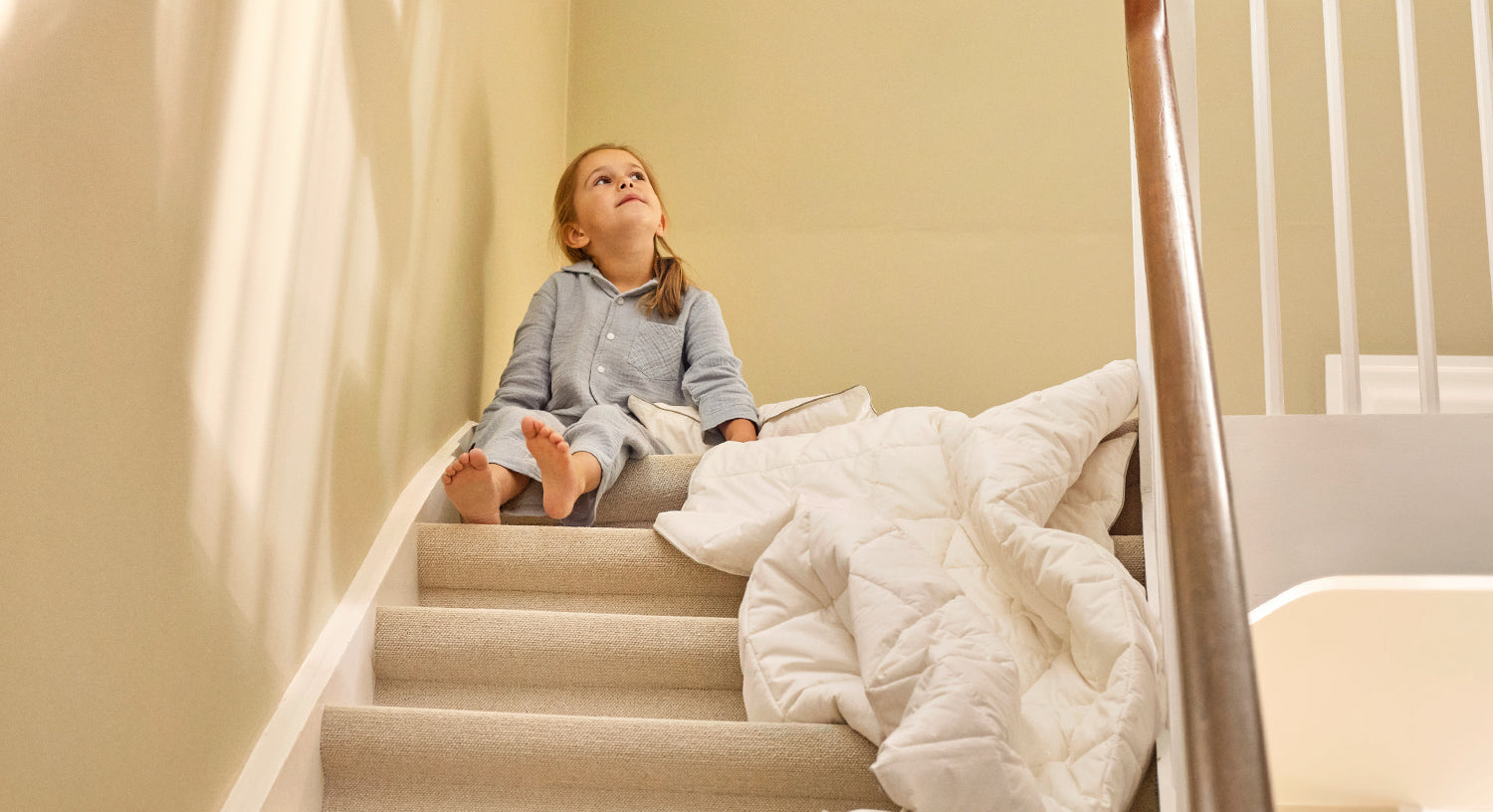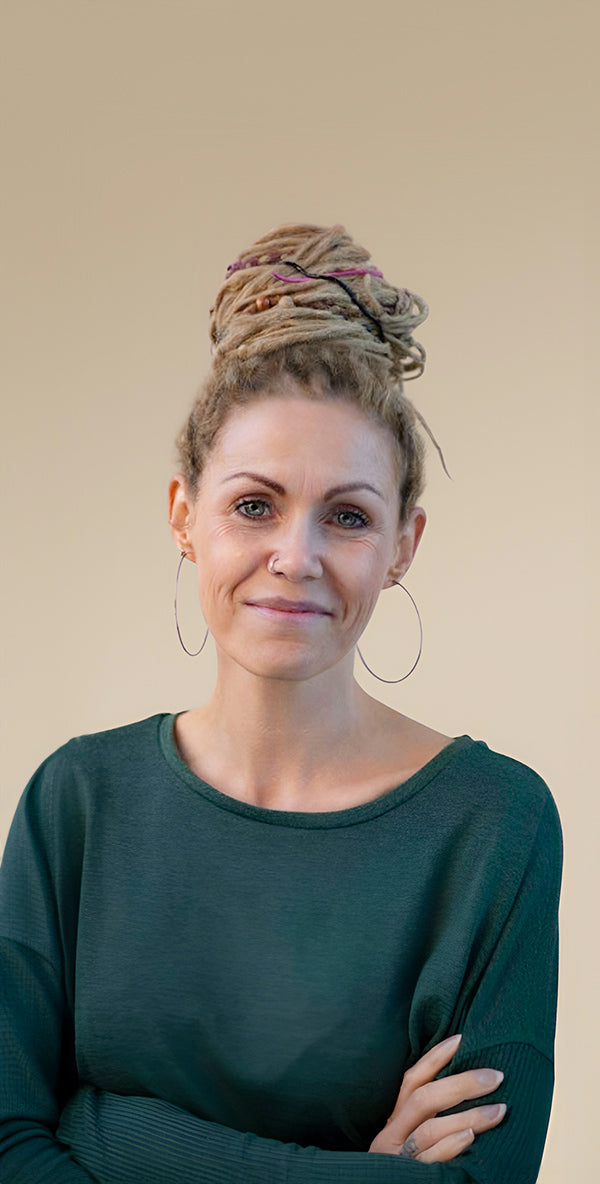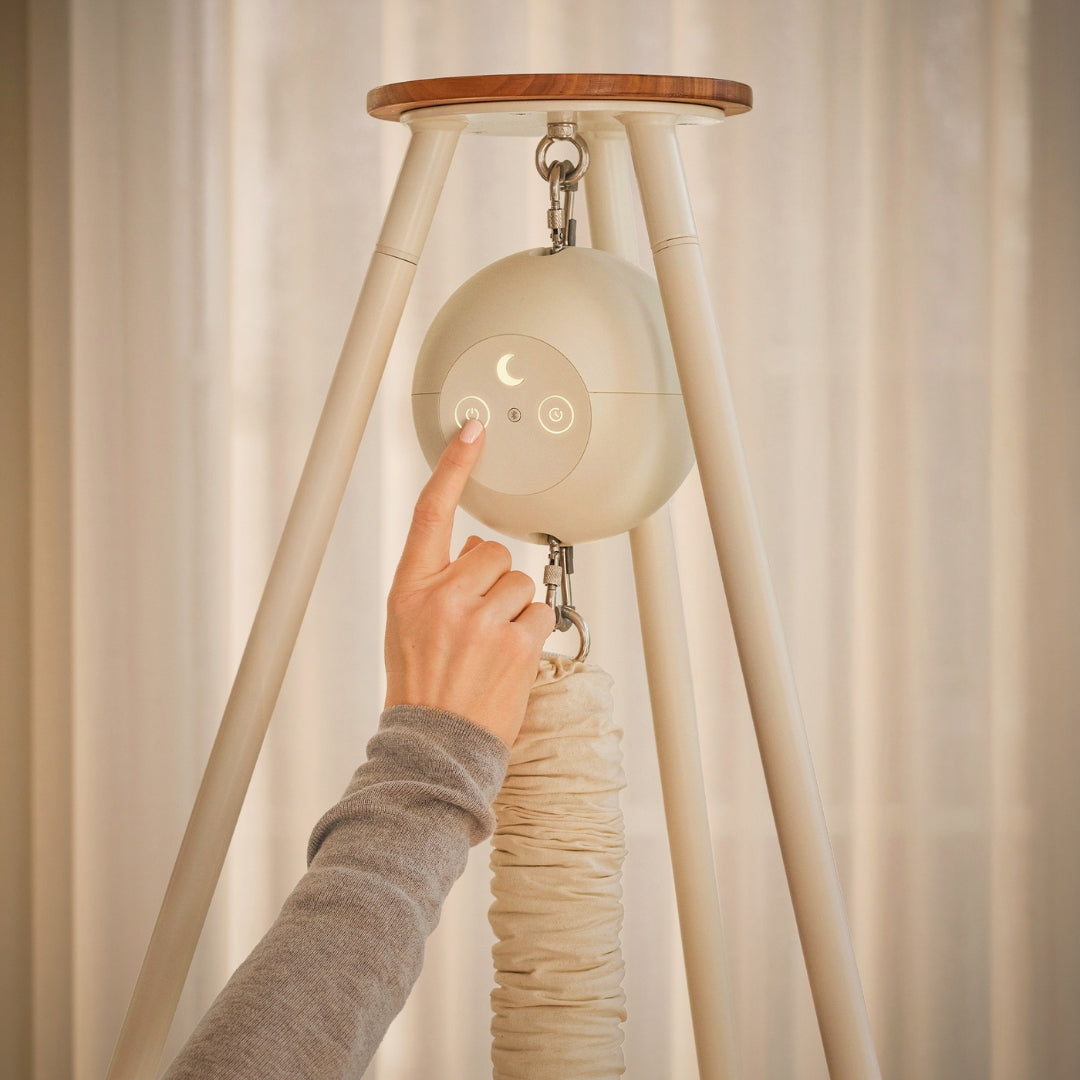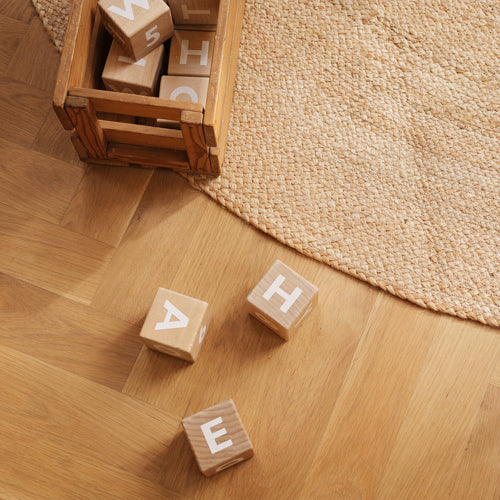


Almost wherever you read or whoever you talk to, there is a broad consensus that it is important to have a tuck in routine or ritual - really important. There are countless descriptions of children falling asleep more easily and sleeping better when they have a tuck in ritual or routine.
Why is a tuck in routine or ritual so important? And perhaps more importantly, how do you create a good tuck in routine or ritual? At what age should you start a tuck in ritual? And is reading a book better than singing a song as part of the tuck in routine?
Sleep counsellor Mia Bjørnfort from Sleeping Children will look at this in this article, and she also gives concrete examples of tuck in rituals for different ages.
The tuck in routine shows the way to calmness - and, thus, sleep
A tuck in routine is essentially just a habit. When you do something in a specific way or in a specific order, every time you do it - it becomes a habit.
Habits create calmness because both body and mind know what needs to happen and can therefore relax. That's why it can be so hard to kick a habit - because your body doesn't want to leave that comfort zone; it just wants things to stay the way they are. 'Used to' is safe and nice.
|
The nervous system is key If we're being a bit nerdy, 'used to' allows the body to stay in the parasympathetic nervous system, which is the body's balance, where it relaxes and recharges, and where blood pressure, heart rate, and cardiac activity are lowered. New things, on the other hand, can make the body a little wary of what might happen next, how it might feel and whether it might be dangerous The body is here in the sympathetic nervous system - ready to defend itself when needed with heightened senses and peak concentration. Maybe you know the feeling from the first day at a new job? Your body has almost been given a boost of energy by tension and nervousness. Whether we call it a (tuck in) habit, a (tuck in) routine or a (tuck in) ritual - it's the recognisability of 'what we are used to doing' that brings peace. |
Sleep can't happen in the sympathetic nervous system - no matter how many times you rock and 'shush' and sing 'Rock-A-Bye, Baby'. It's pure biology - and it's why the vast majority of babies and children need help to settle into sleep. That help will often be part of a tuck in routine.
You can find out more in our article on sleep support right here.
The tucking in already begins when you get up
Yes, we know it sounds crazy, but it's true. Let us explain.
Humans have an internal biological body clock that controls the body's functions around the clock. It's super smart that the body understands that during the day, you are active, and at night you sleep. If this internal clock is off, then even 5 books, 7 lullabies, and an hour and a half of rocking every night won't matter - there will be no balance in the body and, therefore, no balance in sleep.
Both new and older research suggests that a regular wake-up time, when the body is exposed to plenty of light, is one of the strongest factors in a healthy and balanced circadian rhythm. So if you want to create a good tuck in routine, it's obvious to start by supporting the circadian rhythm so that the body is in balance and can actually get something out of the tuck in ritual.
We've written a whole blog post about circadian rhythms, which you can read right here.

The tuck in ritual must suit the child's needs and age
The younger the child, the simpler the tuck in ritual needs to be. It doesn't make much sense to read a chapter of Goodnight Moon to a 3-month-old baby, whereas an older sibling might enjoy just that.
At the same time, a tuck in ritual can also turn out to be too long, contain too many things and actually end up being a really boring affair that doesn't even end in sleep.
Below we will give some examples of age-appropriate tuck in rituals. These are suggestions only - if you've found something that works super well for you, then, of course, that's what you should do.
Note that the age groups overlap to take account of children's individual development.
Tuck in ritual for baby 0-3 months
A very young baby has not yet learned to 'be in the world' and will, therefore, in most cases, need lots of body contact, rocking movements, and milk to settle into sleep. This is perfectly normal and supports the baby's transition from the womb to the big wide world.
Here are some examples of a tuck in routine for a very young baby who doesn't yet know the difference between night and day.
- The lights are dimmed, a clean nappy and milk, and the baby lies in the baby hammock or baby wrap while the older siblings have books read and bedtime songs are sung beside them. Maybe more milk every now and then - that's perfectly normal.
- The lights are dimmed, a clean nappy and milk, and the baby falls asleep in a baby wrap while quiet music plays or the TV is on low.
- The lights are dimmed, a clean nappy and milk, and the baby falls asleep belly-to-belly or at the breast while the baby is cuddled and a song is sung.
Note: Such a small baby can easily eat on/off over some time during napping. You may have heard it referred to as 'refuelling for the night'. Unfortunately, this doesn't mean that baby won't need milk at night, too, although that would be nice.
Tuck in ritual for baby 2-6 months
With a baby of 2-6 months, you can start to add a fun activity to the tuck in ritual, as the baby is now more curious about the world, its body and the people around it.
Here are some examples of a tuck in routine for a small baby of 2-6 months who has an incipient circadian rhythm and is, therefore, slowly learning the difference between night and day.
The basic form is that the baby is prepared for the night and has one goodnight activity, which is only carried out in conjunction with the tuck in for the time and is thereby helped to sleep.
- The lights are dimmed, put on a clean nappy and pyjamas while counting toes or singing a playful song. Brush teeth/gum, a sip of milk and then into the baby hammock or hold on the arm/lap while the older siblings have books read and bedtime songs sung beside them. If the baby is not asleep when the big ones are tucked in, you can continue rocking, give more milk and generally offer regular sleep help
- Dim the lights, a clean nappy and apply some lotion on legs and feet with good deep strokes while you talk about the day that's gone by and what's going to happen tomorrow. Then milk and fall asleep in the baby wrap while soothing music plays or the TV at s low volume.
- Dim the lights and an evening bath that alternates between a real bath and a wash with a washcloth, a clean nappy, nightwear and wonderful milk. Fall asleep in the spoon position, in your arms or at your breast on the big bed or sofa, while the baby is cuddled and a song is sung. The baby may be put in its own bed once it has fallen asleep.

Tuck in ritual for a baby aged 4-12 months
Now the baby starts to be able to link a few actions together and will have a better and better understanding of this. Now you can create a tuck in routine that includes, for example, a book or another activity that the baby participates in.
Now you start to see the difference between the kids who thrive on quiet, quiet, quiet - and those who actually thrive on a little bedtime romp. Some children like both, and here you can combine these so that one tumbles first and, afterwards, is quiet.
Here are some examples of a nap routine for a slightly older baby of 4-12 months who has established a circadian rhythm and understands the difference between night and day. The basic form is that the baby gets ready for the night, has one or two goodnight activities, which are done ONLY in conjunction with the night-time tuck in, and then is helped to sleep.
Calm version
Dim the lights, a clean nappy, put on pyjamas and brush the teeth and gums. You will find one or two books from a small selection of 3-5 books suitable for tucking in, meaning they are short and with very clear action or just picture books. When you have such a small selection, you keep the recognisability, and the book will be calming and not 'exciting'.
When you read or talk about the book, it is at a slow pace and in a calm voice.
During or after reading, the baby is fed milk. When you have finished reading, the baby is helped to go to sleep with the cradle, cuddle, more milk or similar.
It may also be that the baby is fed a little more milk, rocked almost to sleep and then put in a baby hammock with the motor switched on.
It can also be rocking the baby in your arms, sitting on the edge of the bed while it is fed milk, then alternating between sitting and rocking and standing and rocking.
You can also lie together in bed and cuddle, have some milk and, for example, listen to music or sing a song. Or you can tell your baby about the day and what's going to happen the next day in a very calm and slow voice while you cuddle until the baby is asleep.
Romp version
Dim the lights, a clean nappy, put on pyjamas and brush the teeth/gums. You enter the room where the baby sleeps and romp in the bed or on a mattress on the floor. Or you do a 'goodnight dance' where you dance around with the baby in your arms.
Some children enjoy being 'thrown' into the big bed, with the duvet laid in a soft pile, so the baby lands softly - or getting tickled or playing 'peek-a-boo' in a slightly wild version.
Once you've had a bit of a romp, you can make exaggerated sounds of exhaustion ('yawn') to help the baby stop playing and settle down to go to sleep. This can be done by feeding the baby milk and putting it in a baby hammock or by cradling the baby in your arms while sitting on the edge of the bed while feeding it milk.
Or by lying in bed together and cuddling, having some milk and, for example, listening to a sleep hypnosis story or singing a song. Or you tell the baby about the day and what's going to happen the next day in a very calm and slow voice.
Combined romp/calm version:
Dim the lights, a clean nappy, put on pyjamas and brush the teeth/gums. You find a book and go into the room where the baby sleeps. Now you can romp in the bed, roll a ball/move around on a mattress on the floor or have a 'goodnight dance' where you dance around with baby in your arms.
When you have romped for as long as you like, or for example, kicked a ball 10 times, danced to one song or jumped in bed 5 times, you get out the book and read it.
You now help the baby to sleep, for example, by feeding the baby milk, rocking it almost to sleep and then putting it in a baby hammock with the motor switched on.
It can also be rocking the baby in your arms, sitting on the edge of the bed while it is fed milk, then alternating between sitting and rocking and standing and rocking.
You can also lie together in bed and cuddle, have some milk and, for example, listen to music or sing a song, or you can tell the baby about the day's activities and what's going to happen the next day in a very calm and slow voice, while you cuddle until the baby is asleep.
Tuck in ritual where the baby falls asleep in its own bed/cradle/baby hammock:
Lights dimmed, a clean nappy, put on pyjamas and brush teeth/gums. You find a book and go into the room where the baby sleeps.
You read the book while the baby sits on your lap or while the baby sits/lies in the bed/baby hammock, and you sit on a chair or on the floor next to them. If the baby is in a bed/baby hammock, you can hold hands between the bars/through the opening, or the book can be held on the baby's side.
Maybe the baby needs to be picked up and rocked a little once in a while or needs to tumble around to fall asleep or lie and look around for a while. Maybe the baby is fine lying down by itself but then needs to be rocked completely to sleep.
The process of making sure the baby is comfortable in its sleeping space and - eventually - can fall asleep in bed can vary. Development is rarely linear, and you should not be afraid to pick up the baby and help it to go to sleep, then put the baby down again.
A slow development with one step forward and sometimes two steps back will, in the vast majority of cases, be the safe and secure way forward. Patience ensures that the baby is not rushed and that development takes place at a pace the baby can participate in.
|
Please note: If at any time your child - of any age - becomes upset in the bed/baby hammock, they must be picked up and soothed if a very brief attempt to soothe them in the bed/baby hammock does not work. Children who are not picked up do not learn to become calm in the bed/baby hammock - they learn that they will not be helped even if they signal to be uncomfortable. Some children develop a real anxiety-like aversion to the bed/baby hammock as a result of such an approach and will start crying and fighting just seeing the bed/baby hammock or the room they are sleeping in. Such a reaction can take weeks or months to recover from - so better to take it easy in the beginning than push the child and end up having to start all over again. |
Tuck in ritual for 1-2 year-old child
The baby - or toddler - now has a well-developed understanding of action sequences and can easily understand that putting on pyjamas is the first step in the tuck in routine. Therefore, the child can also understand that putting on pyjamas ends in having to go to sleep - and then we might have trouble.
The child now understands that it is its own person with its own will. For example, the child may resist putting on pyjamas because they just want to continue playing.
If we think about ourselves and how hard it can be to turn off the TV and go to bed, it's quite understandable that it can be really hard when you're little. Tuck in rituals for this age must therefore focus on being something the child enjoys - as much as possible.
There is not much difference between the tuck in ritual for a smaller child of 4-12 months and the tuck in ritual for a child of 1-2 years. The biggest difference is probably that some children no longer drink milk at bedtime and that you can maybe, for example, read two or even three short books or one long book, as the child can now pay attention for longer and needs a little more time to settle down.
Bedtime romp can be extended with some jumping in the bed, forward rolls or being tucked in tightly in the duvet and 'kneaded' like dough. This helps the child to feel their body before going to sleep.
It's still normal for the child to need cuddles and snuggles and to be rocked and helped to go to sleep. The expectation that the child can lie still and fall asleep unaided is unrealistic for the vast majority of parents and can create situations where the parents ask the child to do something they simply cannot do.
Calm version:
Dim the lights, a clean nappy, put on pyjamas and brush the teeth while you tell your baby what to do next: 'You need to put on your pyjamas and brush your teeth.
Then we have to find a book to read, and when we've read, it's time to sleep'. Going over the tuck in ritual gives the child a clear idea of what is going to happen and supports the child in feeling that you are in this together.
Find one or two books that are suitable for tucking in. It's about recognisability, so it can be good to alternate between a smaller selection of books. Some children like to read the same book for weeks at a time.
When you have finished reading, the baby is helped to go to sleep with rocking, cuddling, more milk or similar.
The child may be fed a little more milk or a sip of water, rocked almost to sleep and placed in a baby hammock with the motor switched on.
You might also sit on the edge of the bed with your child in your arms while you sing and rock quietly.
You can also lie in bed together and cuddle, listen to sleep hypnosis or bedtime story or sing a song. Or you can use a very calm and slow voice to tell your child about the day and what will happen the next day.
Romp version:
Dim the lights, clean nappy, put on pyjamas and brush teeth while you tell your baby what to do next.
For example: 'You need to wear pyjamas and brush your teeth. Then we'll do 10 forward rolls - that's as many times as your fingers/toes. Come on, let's count: one, two, three .... TEN! And then I'll throw you into the bed so you get to sleep until tomorrow'. Going over the tuck in ritual gives the child a clear idea of what is going to happen and supports the child in feeling that you are in this together.
You enter the room where the child sleeps and romp in the bed or on a mattress on the floor. Or you can have a 'goodnight dance', where you dance around with the child, possibly in your arms.
Some children enjoy being 'thrown' into the big bed, where the duvet is piled softly, so they land softly - or getting tickled or jumping into bed and falling over.
When you've had a bit of a romp, you can tell your child that it's 'the last time', or when this song/roll is finished, it's bedtime.
Maybe you lie together, maybe you sit, holding hands. Maybe the baby gets some milk or a sip of water and is lulled to sleep sitting on the edge of the ,. Maybe you listen to a sleep hypnosis story, sing a song or, in a very calm and slow voice, tell your child about the day and what will happen the next day.
Tuck in ritual, where the child falls asleep in its own bed:
Lights dimmed, clean nappy, put on pyjamas and brush teeth/teeth. You find a book and go into the room where the child sleeps.
You read the book while the child sits on your lap or sits/lies in bed, and you sit on a chair or on the floor next to them. If the child is in a bed with bars, you can hold hands between the bars/opening, or the book can be held on the child's side.
Maybe the child needs to be picked up and rocked a little once in a while.
Maybe the child needs to tumble around to fall asleep or lie and watch for a while. Maybe the child is fine lying down by itself but then needs to be rocked completely to sleep.
Tuck in ritual for children aged 3-4 and 5 or older
When the child is 3-4 years old, there is often a desire - or even an expectation - that the child can be put to bed with a book and a kiss and then lie down to go to sleep on their own. Some expect this even earlier.

To be honest, most parents can't help but have days when they just want that child to sleep – preferably 5 minutes ago. Not because we don't love the child or understand the importance of time and quiet. Only because we are tired, exhausted and just want to have 'time off'.
Some children are ready to fall asleep without the constant presence of a parent already at the age of 3-4, some even earlier. Some children are not ready until they are 7-8 years old, perhaps even later, if earlier attempts to 'go to sleep on their own' have been just persistent enough to cause negative bedtime experiences.
The toddler or older child may have a lot of resistance at bedtime – especially if they find that the parents are 'in a hurry' to get the tuck in routine over with or the child is faced with, for example, falling asleep alone, even though the child is not ready for this.
There is no immediate difference in tuck in rituals for this age group and the age group 1-2 years. Some children have something to drink, romp around, read a book or listen to sleep hypnosis, bedtime stories, or music. Some children lie alone, and some lie with a parent or sibling.
For example, if you want to try going to and from the child, it might look like this:
I forgot something:
The tuck in ritual is over, and goodnight has been said. But hey, you forgot something - something you have to do.
- 'I think I forgot to put the milk in. I'll just check and come back.'
- 'Oh, I really have to pee.'
- 'Oops, I forgot your pacifier.'
- 'I think the cat/dog is doing something it shouldn't. I'll go check.'
Feel free to talk the child while you are away. For example, 'I'll be there in a minute' or 'Okay, I think I'm done now'.
It's very important that you don't delay returning in the beginning. You need to return quickly so the child feels they can rely on you – and never leave if the child is uncomfortable about it.
You can just... I'll be right there:
You're in the middle of the tuck in ritual and about to jump or read a book, for example. You start the activity and say you'll be right back after you've peed, washed the pot, or let the cat in.
You call to the child while you're doing this, 'Are you still jumping? I'll be right there' – and then you actually return.
The idea is that the child is in bed for a while by themselves in preparation for lying in bed while you 'just have to do something' as described above.
I'll clean up while you go to sleep:
Before you start the tuck in ritual, tell your child that today you can read 2-3-4 books or do 20-30 more forward rolls than you usually do, and then your child can lie and listen to music, an audiobook or you sing while you clean up the kitchen - and then you will return and sit afterwards.
The idea is to explain to the child that it can have more fun if you clean up while the child is lying down. In the beginning, you need to be quick to clean up, and you call out to your child several times that you 'just need to do the pots' and 'I just have to clean the table' so that your child understands that you are really cleaning up the kitchen.
In time, your child will slowly get used to lying down on their own, with your voice reassuring them that you're still there - or the sounds of pots and water.
If the child calls, you go to the child immediately and calm them down.
You can then try to say that you, 'I just have to finish up'. If the child is uncomfortable lying alone, or if you leave, or if the child cries, you will naturally stay with them.
Tuck in ritual for baby from 9-10 months or child of 1-2 years with 'motor restlessness' at bedtime
Some children have so much energy to use their bodies when they are about to go to sleep that they need a LOT of help to fall asleep.
Part of that help can be getting all that energy out of the body before you try to get your baby to go to sleep. Simply add some evening exercise to the tuck in routine, as described in the examples for babies aged 4-12 months.
|
Motor restlessness We often encounter the description 'motor restlessness' when, from around 3-4-5 months of age, the baby starts to catch its feet, wriggle, and get up on its hands or even both hands and knees. Towards 8-11 months, many children will also start to sit up, get up on their knees or feet by the furniture and generally just be so busy practising all the new cool things their body can do. Also, at tuck in time or in the middle of the night - sometimes apparently in their sleep. This is normal baby behaviour. Using the description 'motor restlessness' is inappropriate - although we understand how it might seem like an accurate description. The baby puts a big effort into getting its motor skills under control. In the vast majority of cases, it does not exhibit behaviour that can be described as 'restlessness', understood as something that deviates from normal behaviour. In the vast majority of cases, this decreases with age, and the child becomes more confident as they master the skills. Many children can be helped to go to sleep without a lot of moving around by using their bodies during the day or before bedtime. And, for example, by adjusting the distribution of the day's sleep, so that the child is actually tired enough in both body and mind when it's tuck in time. If you have concerns about whether your baby's body movements at bedtime are normal, you can always ask your local occupational therapist or physiotherapist for a brief consultation. |
Sometimes it's not enough. Sometimes even romping during tuck in time, in the afternoon and throughout the day at home or in childcare will not be enough. Sometimes even deep joint pressure, an Epsom bath followed by lotion, tucking the baby tightly in the duvet and rocking or jumping on the yoga ball for 30+ minutes won't be enough.
Sometimes, even a thorough review of the child's overall circadian rhythm, with wake-up times, naps and bedtimes, will make no difference to the child's energy levels at bedtime.
Sometimes you can have done all these things, possibly with the guidance of a childcare provider, or health nurse or occupational therapist/physiotherapist - and the child still has a really hard time calming down at bedtime.
It's a real shame for the child - and the parents. Children sleep if they can. And if they can't, it's usually not because their parents don't know how to tuck them in or that they don't 'want' to. Then it's because they need help to sleep, maybe a different kind of help than they get, or because something is preventing them from sleeping.
For some, a weighted vest or a weighted sleeping bag can provide the 'final touch' to help the child find peace in their body. Weighted products can be part of an overall effort to help calm the child's body before and during the tuck in ritual.
It's just important to understand that a weighted vest or weighted sleeping bag is not a quick fix that suddenly puts your child to sleep in 5 minutes and all night. While there will certainly be parents who will experience just that, it should not be the expectation when assessing whether to purchase a weighted product.
A tuck in routine with a weighted product looks like a normal tuck in routine - the child just wears a weighted vest, for example, while reading aloud, and the child falls asleep, then it's taken off.
It can also be the baby wearing a weighted sleeping bag while having a bedtime story read or listening to a sleep hypnosis story, after which the baby falls asleep with the sleeping bag on and it is gently removed when the baby is sleeping heavily or at the first awakening.
So there's no mumbo jumbo about it - it's a tool you can use, just as you would use a duvet to tuck your child in tightly or a particular teddy bear that your child needs to cuddle.
Summary:
- A tuck in routine is essentially just a habit. When you do something in a specific way or in a specific order, every time you do it - it becomes a habit.
- Whether we call it a (tuck in) habit, a (tuck in) routine or a (tuck in) ritual - it's the recognisability of 'what we are used to doing' that brings peace.
- Get up at the same time every morning: if you want to create a good tuck in routine, it is obvious to start by supporting the circadian rhythm so that the body is in balance and can actually benefit from the tuck in ritual.
- The younger the child, the simpler the tuck in ritual needs to be.
- The basic form of any tuck in ritual and all ages is that the child gets ready for the night, has one or two goodnight activities that are done ONLY in conjunction with tucking in for the night, and then is helped to go to sleep.
- At 0-3 months, most babies' tuck in routine will simply be milk and the hammock.
- With a baby of 2-6 months, you can start to add a fun activity to the tuck in ritual, as the baby is now more curious about the world, its body and the people around it.
- At 4-12 months, a tuck in routine can be created, which includes, for example, a book or another activity in which the baby participates.
- At 4-12 months, you start to see the difference between the children who thrive on quiet, quiet, quiet - and those who actually thrive on a little bedtime romp.
- By 1-2 years, the baby or toddler has an understanding of action sequences. Therefore, the child can also understand that putting on pyjamas ends in having to go to sleep - and then we might have trouble. Tuck in rituals for this age must therefore focus on being something the child enjoys - as much as possible.
- Expecting a 1-2-year-old to be able to lie still and fall asleep unaided is unrealistic for the vast majority of parents and can create inappropriate situations where the child is asked to do something it simply cannot do.
- By the time the child is 3-4 years old, there is often a desire - or even an expectation - that the child should be able to be tucked in with a book and a kiss and then lie down and go to sleep on their own.
- Some children are ready to fall asleep without the constant presence of a parent already at the age of 3-4, some even earlier. Some children are not ready until they are 7-8 years old, maybe even later.
- We often encounter the description 'motor restlessness' when, from around 3-4-5 months of age, the baby starts to catch its feet, wriggle, and get up on its hands or even both hands and knees. Towards 8-11 months, many children will also start to sit up, get up on their knees or feet by the furniture and generally just be so busy practising all the new cool things their body can do. Also, at tuck in time or in the middle of the night - sometimes apparently in their sleep. This is normal baby behaviour.
* If you have any concerns about whether your baby's bedtime movements are normal, you can always talk to your doctor or health nurse or ask your local occupational therapist or physiotherapist for a brief consultation. - Some children have so much energy to use their bodies when they are about to go to sleep that they need a LOT of help to fall asleep. Even after careful adjustment of the child's circadian rhythm and sensory stimuli throughout the day.
Weighted products can be part of an overall effort to help the child calm down before and during the tuck in routine.




































